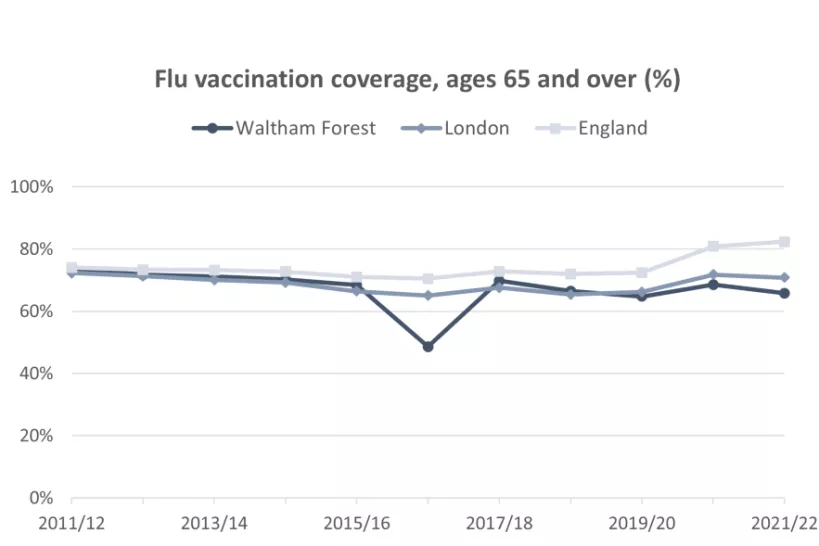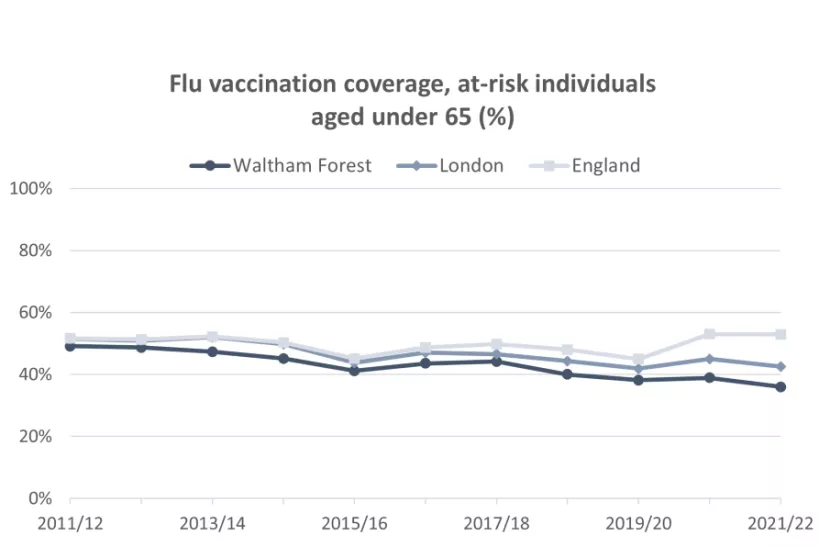Last updated: 31 May 2024
Next review: 1 December 2024
This content is part of the Waltham Forest JSNA. To see other JSNA content, visit the JSNA landing page
Influenza (also known as flu) is a highly infectious viral illness which can spread rapidly in communities. Even people with mild or no symptoms can infect others. The flu vaccination is offered to people at greater risk of developing serious complications from flu (particularly older adults and people with clinical risk factors). It is also offered to other groups, such as children and carers, to reduce flu transmission in the community and to frontline health and social care staff to reduce spread to vulnerable groups and minimise staff absence. Reducing flu transmission in the community helps to reduce cases of severe flu and flu-related deaths in older adults and people with clinical risk factors and contributes to easing winter pressure on primary care services and hospitals.
From Autumn 2022, everyone aged 50 years and over are eligible for a free flu vaccination (previously 65 years and over). Flu vaccine is also offered to anyone with long-term health condition, pregnant, living in a residential or nursing home, carers, frontline health and social care workers, people living with someone who has lowered immunity, children aged 2 and 3 years of age, all primary school-aged pupils, and some secondary school-age children. [1]
Flu vaccination coverage ages 65 and over
Flu vaccine uptake among people aged 65 years and over in England increased in winter 2020 to 2021 with uptake increasing from 72.4% in 2019 to 2020 to 80.9% in 2020 to 2021 (8.4 percentage points). The increase was smaller in London region and in Waltham Forest (5.6 and 3.7 percentage points respectively).
In 2021 to 2022, the flu vaccine uptake among people aged 65 years and over declined slightly in Waltham Forest, and in London as a whole. The coverage was 65.8% in Waltham Forest and 70.8% across London, whereas the England average continued to increase and reached 82.3% (highest uptake recorded since 2010 to 2011).

Source: OHID Public Health Outcomes Framework. Date accessed: 26 April 2023.
Flu vaccination coverage, at-risk individuals aged under 65
Flu can affect everyone, but it can be worse for those with long-term health conditions or lowered immunity due to disease or treatment. The list of conditions is not definitive but includes conditions such as heart problems, asthma, kidney or liver diseases, diabetes, neurological conditions, problems with spleen, and being severely obese (BMI of 40 and above). [1]
In 2021 to 2022, the national ambition was to achieve at least 75% uptake of flu vaccine amongst those aged 6 months to 64 years in one or more clinical risk group, given their increased risk of morbidity and mortality from flu. However, coverage among this at-risk population (excluding pregnant women) remained significantly below the target, with uptake reaching only 52.9% in England; 42.5% across London, and only 36.0% in Waltham Forest, which is the lowest uptake recorded in Waltham Forest since 2010 to 22.

Source: OHID Public Health Outcomes Framework. Date accessed: 26 April 2023.
References:
[1] UK Health Security Agency (2022). The flu vaccination: who should have it and why. Date accessed: 04 May 2023.